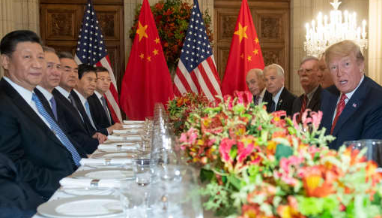- Ameya360 Component Supply Platform >
- Trade news >
- Trade war could cut China's growth by nearly 2 percentage points over two years: IMF
Trade war could cut China's growth by nearly 2 percentage points over two years: IMF
At its worst, the ongoing trade tensions could knock 1.6 percentage points off China's economic growth over the first two years, according to an analysis by the International Monetary Fund.
The assessment took into account all current and proposed tariffs on Chinese goods that enter the U.S., as well as knock-on effects the trade tensions have on investor confidence and financial markets. But much of that impact is expected to be offset by the Chinese government's policies to stimulate the economy, noted Changyong Rhee, director of the IMF's Asia and Pacific Department.
The analysis was published on Friday in the IMF's Regional Economic Outlook report focusing on the Asia Pacific region.
Rhee told reporters that direct economic impact from the tariff fight between the U.S. and China is actually "quite small." What's more detrimental is the hit to investor confidence, which has rattled financial markets and is likely to last for a while, he said.
"This is one of the reasons why we feel that headwinds may last longer," Rhee said. "I don't know what will be the end ... I think the lessons we have taken is how much the global financial markets and real economy are well integrated, no one can be free from such shocks."
"In the end, there will be no winner from the global trade war," he said in Bali, Indonesia where the IMF and the World Bank are holding their annual meetings.
The U.S. has implemented additional tariffs on around $250 billion worth of Chinese goods that enters its borders, and China has retaliated with extra levies on roughly $110 billion of imports from the U.S.
President Donald Trump's administration has said that it would target another $267 billion of Chinese products, which is nearly all of its remaining imports from the Asian giant.
The tit-for-tat tariffs between the world's two largest economies has hit investor confidence. This week, renewed worries about the global economy — weighed down by trade tensions — led to a sell-off in global markets. Chinese stocks have been among the worst hit, having declined more than 20 percent this year.
The IMF earlier this week downgraded growth forecasts for the global economy for 2018 and 2019, and China hasn't been spared.
The world's second-largest economy is expected to grow at 6.6 percent this year — maintaining an earlier forecast, but its estimated growth next year has been lowered by 0.2 percentage points to 6.2 percent, according to the report. Without the recent steps taken by Chinese authorities, the Asian giant's growth prospects could be even lower amid the escalating trade tensions with the U.S., the IMF said in the report.
China's central bank has cut the amount of reserves held by Chinese banks four times this year, which have helped to stimulate economic activity. But doing so may delay China's structural reforms, the IMF noted in the report.
"Macro policies in China have been focused on addressing the economy's significant and longstanding financial vulnerabilities, but the shift toward stabilizing growth may mean slower progress on deleveraging and thus heightened medium-term risks for China and the entire region," the report said.
Online messageinquiry

China's Xi is about to deliver a speech that could have major consequences for the trade war

US will hold off on raising China tariffs to 25% as Trump and Xi agree to a 90-day trade truce

Expect a photo op and a 'mock deal' at the Trump-Xi meeting — not a long-term truce, says economist
- Week of hot material
- Material in short supply seckilling
| model | brand | Quote |
|---|---|---|
| CDZVT2R20B | ROHM Semiconductor | |
| TL431ACLPR | Texas Instruments | |
| BD71847AMWV-E2 | ROHM Semiconductor | |
| RB751G-40T2R | ROHM Semiconductor | |
| MC33074DR2G | onsemi |
| model | brand | To snap up |
|---|---|---|
| IPZ40N04S5L4R8ATMA1 | Infineon Technologies | |
| STM32F429IGT6 | STMicroelectronics | |
| BP3621 | ROHM Semiconductor | |
| TPS63050YFFR | Texas Instruments | |
| BU33JA2MNVX-CTL | ROHM Semiconductor | |
| ESR03EZPJ151 | ROHM Semiconductor |
- Week of ranking
- Month ranking
Qr code of ameya360 official account
Identify TWO-DIMENSIONAL code, you can pay attention to


Please enter the verification code in the image below:






















